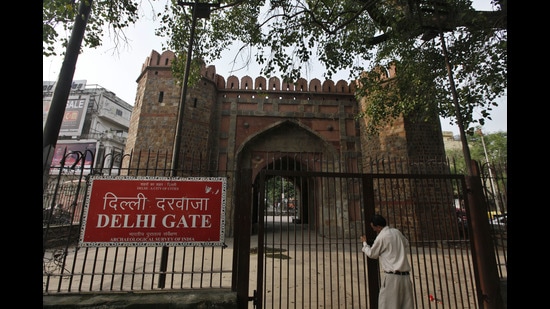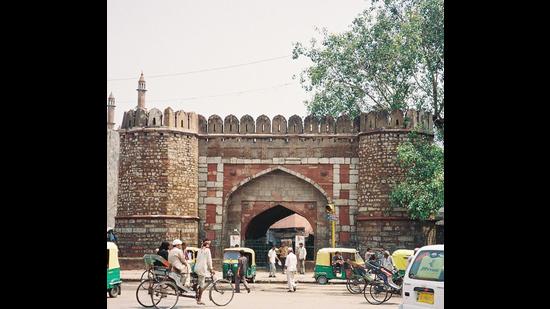World Tourism Day: Knocking at Delhi’s gateway to history
On World Tourism Day (September 27), we look at how the gates have always played a crucial role in shaping Delhi’s history. Only four out of 14 gates exist in the Capital today, and these are Kashmere Gate, Delhi Gate, Ajmeri Gate and Turkman Gate.
The Delhi government’s plan to beautify entry points of the Capital, in order to make the city more aesthetically appealing, is finally set to take off. As part of this, five entry points will be beautified, and sculptures as well as large LCD screens will be placed on 200 metre stretches here. These points will include the borders at Gurugram, Tikri Kalan, Ghazipur, Apsara, and Anand Vihar near Kaushambi.

But when has Delhi ever been a stranger to entry point/gates (darwaza)? An integral part of the city’s history and architecture, its gates have often piqued the interest of denizens as well as tourists. Back in 1911, when the British Empire shifted the Capital from then Calcutta (now Kolkata) to Delhi, it’s recorded that the city was surrounded by 14 gates! Out of these, only four have survived the test of time. These are namely — Kashmere Gate, Delhi Gate, Ajmeri Gate and Turkman Gate.

“A European merchant from 17th century, William Finch described Delhi as the city of 7 cities and 52 gates,” exclaims Eshan Sharma, founder of a student led heritage exploration initiative named Karwaan. He adds, “The walled city of Shahjahanabad had, for example, 14 gates! One would leave from the Delhi Darwaza to reach straight to the original Delhi, which was Mehrauli. Similarly, Lahori Gate (Darwaza) led to Lahore. Such was the orientation of these two gates of Red Fort.”
All these gates have their own narratives seeped in history, which comes together to shape what’s today known as Delhi’s rich cultural heritage. The 19th and 20th century historians refer to Shahjahanabad as modern or New Delhi. Author and historian Rana Safvi has explored the historicity of Delhi’s gates in her book Where Stones Speak: Historical Trails in Mehrauli, the First City of Delhi. She says, “When Shah Jahan built Shahjahanabad, he built the city’s gates and named them after the areas they led to — Lahori Gate, Kashmiri Gate, Ajmeri Gate, Kabuli Gate. In fact, there still is one gate, that is Delhi Gate, which was the odd one out, and that’s when you realise that the Delhi here refers to the old city of Mehrauli, and not Shahjahanabad!”

Similarly, the Turkman Gate also has a rather interesting anecdote behind its name. “Turkman Darwaza was the only one of the 13 gates that gave access into the walled city of Shahjahanabad, which was named after a saint and not the city that the road led to,” informs Safvi, adding, “Shah Turkman Bayabani, also known as Dada Pir, was a very famous saint who died in 1240. As his name indicates, he lived in the then unin (bayaban) habited part of the city, which we know now as Delhi and thus the term. Today, that area is densely populated and his dargah is lost somewhere inside an area called Mohalla Qabristan. A smaller dargah adjacent to the Chandni Mahal police chowki is wrongfully attributed to him. People flock it thinking it’s the shrine of the famous 13th century saint. The Dada Pir meanwhile sleeps a little further ahead and deep inside the residential area. Gone is his bayaban!”

These gates of Delhi have been such an intriguing subject for not just Delhiites but also tourists. And that has inspired some special heritage walks which talk about the history of multiple gates during their course. Ramit Mitra from DelhiByFoot, who conducts one such walk, shares, “There’s a nearly four hours walk where we talk about gates of Delhi and their structures. We start at Ajmeri Gate and make the participants touch three gates during the walk. After Ajmeri Gate, we go along the walls and enter the city for a brief while. Then, we go to the Turkman Gate, and later we again go into the city for a bit, and finally we exit towards Delhi Gate.... Participants of this walk often get to know the now forgotten or lesser known lifestyle and culture of Delhi.”
The Four Gates of Delhi, today!
Kashmere Gate: This gate was attacked when the British conquered Delhi again, during the Indian Uprising of 1857. The British stormed Kashmere Gate and entered the city of Delhi.
Delhi Gate: It’ believed that two criminals were killed, and their bodies were buried in the foundation of the Delhi Gate. This is one of 14 gates that was originally built by Mughal emperor Shah Jahan.
Ajmeri Gate: This gate was named Ajmeri Gate because of the road from it that led straight to Ajmer in Rajasthan. Ajmer was renowned for being a Sufi pilgrimage town, back in those days.
Turkman Gate: This gate was named after Sufi saint Hazrat Shah Turkman Bayabani. And it’s this historical place that played a major role during the emergency of 1975. A massive demolition drive took place here.
Author tweets @anjuri



